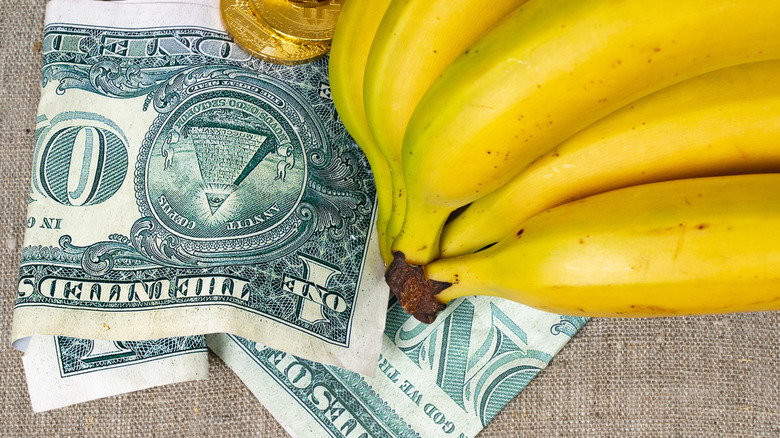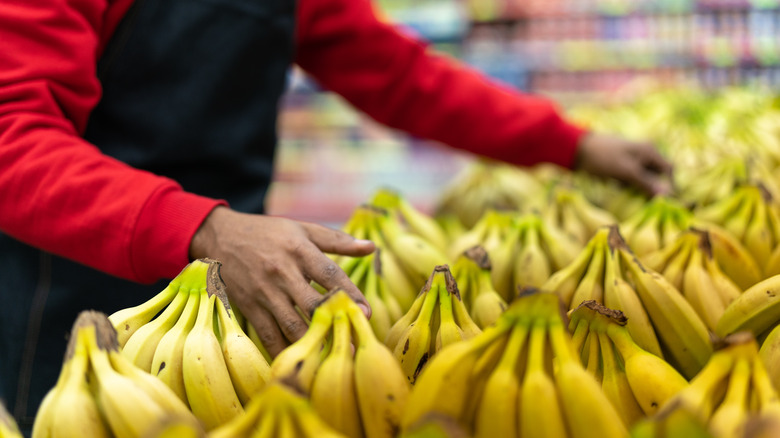Why It Feels Like Bananas Are Untouched By Inflation
Bananas don't get the credit they deserve. From a mess-free snack on the go to powering smoothies and homemade banana bread, there's no natural substitute for the ubiquitous yellow fruit, which, interestingly, is technically a berry! The combined effect of two factors has kept bananas popular (and underappreciated). First, easy availability — there has not been a significant banana shortage in some time. Second, banana prices have remained stable for several decades, and they're invariably one of the cheapest fruits you can buy. Per the U.S. Bureau of Labor Statistics, a pound of bananas has cost roughly between 55 and 65 cents per pound over the last ten years.
Even with prices of other foods and fruits shooting up, bananas have remained affordable. Bananas have been spared the worst of the inflationary effects, and while they may have crept up a hair in cost, given the stability of the crop, and (pardon the pun) fruitful relationship that has been fostered between buyers and growers, few of the costs of production have gotten passed onto consumers. Part of that stable relationship has been the U.S. is always interested in buying up bananas. These days, it's even worth it for gas stations to keep them on hand, and while Starbucks gave up on selling them in 2022, according to BI, Amazon HQs have been giving them away to employees and the public for free since 2015.
Bananas remain cheap because supply is abundant
Bananas are the most produced fruits in the world, significantly ahead of watermelons, which hold second place. As a high-yield fruit that can grow throughout the year, bananas are always available. There is stiff competition between countries that supply the fruit since banana exports support their economies. However, this competition amongst suppliers also means that banana prices get pushed down. Combined with the fruit's quick ripening, suppliers want to sell them quickly, often settling for lower prices. This is in addition to the fact that bananas are typically grown in tropical South American and South Asian countries where wages are lower relative to some of the places they're being sold and shipped.
The other factor keeping prices down is retail chains. Over the years, large-scale retailers have started sourcing directly from banana growers and small-scale distributors, which helps them get a better price. While this reduces the overall cost of getting the fruit from the farm to the supermarket shelf, it also means that retail chains can exert pressure on small banana suppliers to keep prices down, especially given the stiff competition among suppliers. The U.S. currently gets over 40% of its bananas from Guatemala, the third largest producer of the fruit, trailing Costa Rica and Columbia. Considering all three suppliers are neighboring countries, it's not difficult to imagine one being substituted for the other by a retailer looking for a lower price.
Banana prices have risen so slowly, that (so far) it's barely noticeable
While stiff pressure exists to keep banana prices unchanged, the costs associated with growing bananas also undergo inflation. Energy, oil, and labor have all become more expensive, putting pressure on the growers' profit margins. Then there are costs associated with delays in transport; small supply irregularities such as these are often managed by banana ripening centers that can accelerate and decelerate the pace at which bananas mature, keeping the supply, and therefore consumer prices level.
More significant factors like changes in the weather and the spread of a plant disease called Fusarium Wilt TR4 adversely affecting plantations have led to an increase in the costs of growing bananas. This has translated to a price rise of a few cents on the store shelves. A great example of how the price is managed is Trader Joe's, where the price of a banana was raised to 23 cents after being 19 cents for over two decades. This rise may not seem like much to a consumer, but it adds up to a significant amount for retailers and banana suppliers.
If you buy bananas, it's unlikely that the price will rise so much that you'll stop buying them. However, expect to spend a few more cents on them, which you may not even notice given how much more every other fruit on the store shelf has gone up.


